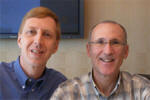May 2012
Column
AutomatedBuildings.com
[an error occurred while processing this directive] (Click Message to Learn More)
Unexpected and Unknown Results
Paul Ehrlich, Ira
Goldschmidt
& Angela Lewis
Building
Intelligence Group
W
e expect controls and building automation systems (BAS) to operate
buildings in an efficient manner, keeping the occupants’ safe,
comfortable, and doing so using as little energy as possible. But
often these systems do not work properly. They fail due to a
number of problems including errors in design, installation, and
construction. But most often the problems are due to changes
introduced in operation, often as a result of changes to building use,
failed components, or system upgrades.
While it is not remarkable that these systems fail, what is surprising
is that many failures go without being noticed. How is this
possible? The short answer is that as long as the building
remains somewhat comfortable, the systems are assumed to be
working. When a problem impacts comfort, for example a control
valve that doesn’t open allowing a unit to cool, then the system
operator will typically look for the problem and get it resolved.
But when the problem does not directly impact comfort they become both
unexpected and unknown. This leads us to the old saying about
these systems “They don’t work but they aren’t broken.”
The range of system failures is broad, ranging from setpoints, which
are not optimum to sever problems. Here are a few common areas
were we see problems:
- Economizer Controls : We see a lot of problems with the control of economizers on everything from packaged rooftop units to large central systems. The problems range from incorrect setpoints, to bad sensors, to lack of proper setup. The use of economizer is fairly straightforward but improper setup is common and hard to detect.
- Simultaneous Heat and Cool: The use of reheat on VAV systems is critical during cold weather, to de-humidify and to deal with zones that have high ventilation loads but low occupancy. However the use of reheat often covers up much larger system problems. For example we recently evaluated a building were the fans operated continuously, sub-cooling the entire building and forcing reheat to run all night. Since the building stayed comfortable the efficiency problems were readily masked.
- Extended Hours of Operation
: It is not
unusual for the operating hours of building systems to be much greater
then occupancy hours. In fact many buildings end up running
systems 24x7. Frankly leaving things on at all times is seen as
the easiest way to deal with occupant complaints and comfort
problems. Of course doing this results in excess energy for
heating, cooling, as well as ventilation.
[an error occurred while processing this directive]
While resolving many of these problems is not complicated, finding them
can be. There are a series of tools that we use to find and
analyze control system problems. These include:
- Site audits including interviews and equipment inspections.
- Analysis of BAS systems including screens, alarms and trends (if available).
- Extensive data logging using either the BAS or standalone data loggers.
- Evaluation of building level smart meters (when
available).
The most important of these tools are the trends, data logs, and smart
meter information, which occur over an extended period of time.
This allows us to see what is happening at night and on weekends and
also how systems react as the outdoor air conditions vary.
Ideally we would like to see HVAC equipment controls and BAS systems
become self-monitoring and correcting. There has been quite a bit
of work done in this are and “continuous commissioning” tools and
services are now available in the market. But ideally buildings
should be like your car. The systems should operate properly, and
when there is a failure the operator should be clearly notified.
Until this is available in buildings then there will be a need for
engineers to act as detectives looking for the unexpected and unknown.
About the Authors
 Paul
and Ira first worked together on a series of ASHRAE
projects including the BACnet committee and Guideline 13 – Specifying
DDC Controls. The formation of Building Intelligence Group provided
them the ability to work together professionally providing assistance
to owners with the planning, design and development of Intelligent
Building Systems. Building Intelligence Group provides services for
clients worldwide including leading Universities, Corporations, and
Developers. More information can be found at
www.buildingintelligencegroup.com
We also invite you to contact us directly at Paul@buildingintelligencegroup.com
or ira@buildingintelligencegroup.com
Paul
and Ira first worked together on a series of ASHRAE
projects including the BACnet committee and Guideline 13 – Specifying
DDC Controls. The formation of Building Intelligence Group provided
them the ability to work together professionally providing assistance
to owners with the planning, design and development of Intelligent
Building Systems. Building Intelligence Group provides services for
clients worldwide including leading Universities, Corporations, and
Developers. More information can be found at
www.buildingintelligencegroup.com
We also invite you to contact us directly at Paul@buildingintelligencegroup.com
or ira@buildingintelligencegroup.com
[an error occurred while processing this directive]
[Home Page] [The Automator] [About] [ Subscribe ] [Contact Us]

